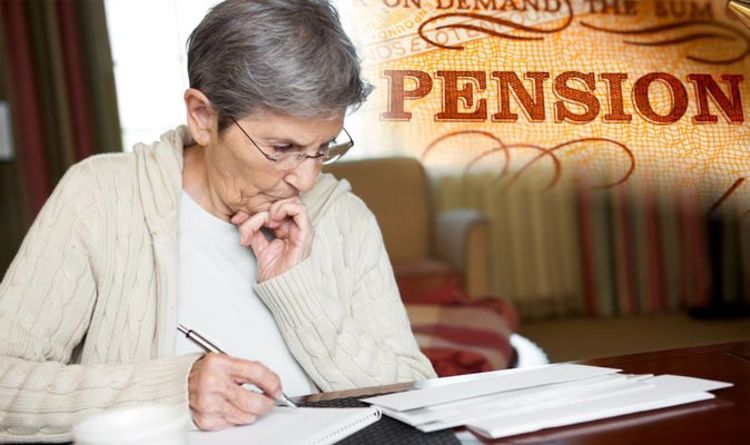Pension contributions GAP: Pensions expert on ‘what was missed’ amid state pension changes
The state pension rules changed on April 6, 2016, with the new state pension rules affecting men born on or after April 6, 1951, and women born on or after April 6, 1953. The new system is known as a flat-rate, or single-tier pension. This differs to the two-tier system of the basic state pension, in which a person receives a basic state pension payment, plus top-ups for those who qualify for them. The current gender pensions gap was highlighted this week, as a new report, Facing an unequal future – closing the gender pensions gap, was published by NOW: Pensions, based on research by the Pensions Policy Institute (PPI).
According to the PPI research, by their 60s, the median women’s pension wealth stands at £51,100.
Meanwhile, the median for men of the same age stands at almost £156,500.
The report also said that with women living 3.7 years longer than men on average, they would need to save around five to seven per cent more than men by retirement age, in order to draw the same pension income throughout their lifetime.
The report also highlighted how 1.2 million women with dependent children are currently looking after their family, and are missing out on auto enrolment contributions.
Despite the proportion of women working now standing at 71.4 per cent – the highest female employment rate since records began in 1971 – 41 per cent of these women were working part-time during the last quarter of 2018.
In comparison, 13 per cent of men work part-time.
Meanwhile, women currently earning approximately 18 per cent less than men on average, and finding suggest that the gender pay gap cuts women’s pension savings by 18 per cent.
Joanne Segars, Interim Chair of Trustees NOW: Pensions said: “Pension saving can be difficult, especially for women.
“Not only are women typically paid less, but they are much more likely to work part-time or take time out of the workforce to care for children or elderly relatives.
Baroness Jeannie Drake spoke during a panel discussion on the report on Thursday, and later sat down for an exclusive interview with Express.co.uk.
During the event, the panel discussed remedied to combat the pensions gap which have been proposed – one of which includes the introduction of a family carer’s top-up.
Baroness Drake later expanded on the matter, telling Express.co.uk that as women are “often characterised by periods out of the workforce” as parents, as well as being more likely to carry out part-time paid work, for many women, their annual amount of pay may not trigger auto-enrolment – meaning they may not qualify for the pension contributions.
“That’s always been a problem. It’s not a new discovery that women pay a care penalty,” she said.
“There was this sort of big argument about that over many years.”
Baroness Drake went on to explain how under the basic state pension system, credits for those who carry out unpaid work as carers, such as for children under 12 or elderly relatives, may have been able to be granted to those carrying out unpaid care work.
“Subject to certain conditions, you would be credited with entitlements to state pensions as though you’d been working,” she said of those carrying out unpaid care.
Baroness Drake said of the changes to the state pension: “They made it more generous, but they said, ‘We don’t want any second-tier state second pension. Your top-up, second-tier pension will be done through auto-enrolment as a private system.’
“But, what was missed was when they did that, what was given away was the right of parents to have a credit in their top-up pensions, which had previously been held through the state.
“My argument was in having won the principles that caring is an economically valuable activity, simply because you’ve made a political decision to put the top-up second-tier pension into a private arena, shouldn’t lose the principle that women should get some credit.”
A DWP Spokesperson told Express.co.uk: “We value the role carers play and are committed to ensuring they get the full support to which they are entitled. Our state pension reforms have made the system simpler and provide a higher level of support in particular for lower paid workers and women, including more than 3 million women who stand to receive an average of more than £550 extra per year by 2030.”
A carer may get National Insurance credits if they cannot work, such as by claiming Child Benefit for a child under 12 (or under 16 before 2010), or by getting Carer’s Allowance.
Baroness Drake noted that the administration of a family carer top-up for pension contributions would require further consideration, however suggested that the process could be similar to that of the former pension system.
“The basic principle is that if you were doing caring of a certain definition, the state credits you with a top-up amount that goes into pensions,” she said. “It’s been done before under the old system, it can be done again.”
According to elsewhere in the report, the state pension gap has been cut by more than 70 per cent with the new state pension.
It states: “Of the three recent policy measures with the biggest impact on the pensions regime, bringing women’s state pension payments further in line has arguably been the most effective.”
Express.co.uk has contacted the Department for Work and Pensions asking for comment.
NOW:Pensions’ five-point plan for fairer pensions
1. Removal of the £10,000 auto-enrolment trigger to get more women into auto-enrolment
This would bring an additional 1.4 million women in pension saving.
2. Auto enrolment contributions on every pound of earnings
This would improve pension part-time workers who are more likely to be women. This would increase pension wealth by 140 per cent at retirement.
3. The introduction of a family carer’s top up
Women taking time out to care are compensated in the State Pension by State Pension credits, however, they miss out on auto enrolment. The family carer’s top up would see the government pay the equivalent of the employers’ contribution at National Living Wage level into women’s pensions who are taking time out to care. This would equate to approximately £820 per year and would boost women’s pension outcomes by 20 per cent. The family carer top-up can close around half of the pension wealth gap created by taking time out of work to care for family.
4. Ensuring that pension funds are always considered in divorce settlements
Approximately 10 per cent of men and 14 per cent of women in their early 60s are divorced. The median pension wealth of divorced men and women by retirement is £103,500 and £26,100 respectively. These figures compared to the population indicate a pension wealth reduction of a third for men but a half for women, signifying a greater impact of divorce for women than men.
Although pension pots can often be the second most valuable asset when people are going through a divorce, they are often overlooked, with people paying more attention to property assets.
In 2018, there were 118,142 divorces but only 4,632 pension attachment orders were made by the family courts.
5. Greater action on the availability and cost of childcare to enable those that want to return to work
Despite tax changes that help families with childcare costs, prices continue to rise. The Family and Childcare Trust reported in 2018 that childcare prices for children under three had risen above both inflation and wages in the previous year. Costs grew by seven per cent to £122 for 25 hours per week, equating to £6300 per year. Analysis of freedom of information request data by Insurer Royal London shows the high cost of childcare means working parents with toddlers pay more for childcare than their mortgage. A full-time nursery place for a child under two typically costs £1,065 a month, for example, while the average monthly mortgage repayment is £1,040 and the equivalent figure for renters is £833.
You may be interested

Sony’s making a handheld console to compete with Nintendo and Microsoft
admin - Nov 25, 2024[ad_1] Sony is currently making a new handheld gaming console that allows users to play PlayStation 5 games anywhere. According…

Davina McCall says she has short-term memory problems after brain tumour surgery
admin - Nov 25, 2024[ad_1] Davina McCall has said that her short-term memory is "a bit remiss" as she recovers from brain tumour surgery.…
Slot Gacor: Ketahui Keuntungan dan Cara Menangnya!
jokuntul - Nov 23, 2024Dalam dunia perjudian online, nama slot gacor pasti sudah tidak asing lagi di telinga para pemain. Slot gacor adalah istilah…
Leave a Comment
You must be logged in to post a comment.
























